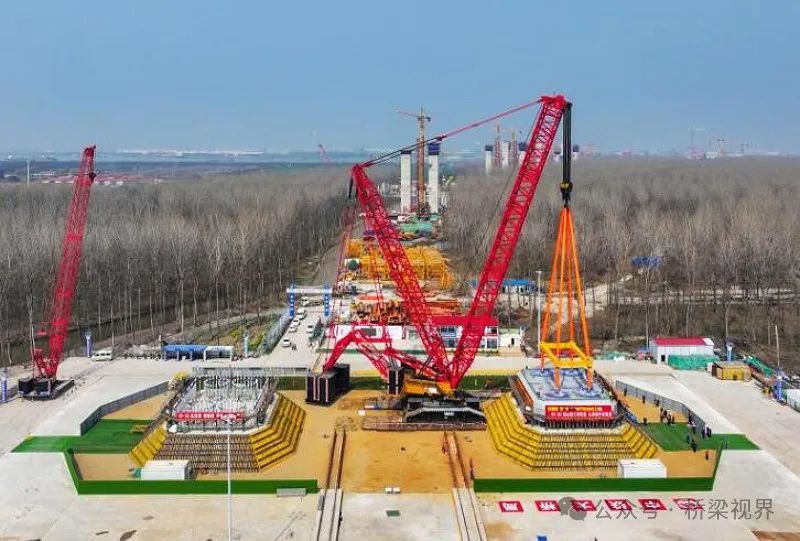On the afternoon of March 16th, a 1,600-ton crawler crane was slowly hoisting the T1 segment of the main tower in the construction area of the north main tower of the Changjingao Yangtze River Bridge’s south navigation channel bridge. Under the orderly command of the on-site production manager, the T1 segment was precisely lowered into the interior of 166 anchor bolts, marking the successful hoisting of the T1 first segment of the north main tower of the Changjingao Yangtze River Bridge’s south navigation channel bridge. The Changjingao Yangtze River Bridge’s south navigation channel bridge is a 2,300-meter main span overall box steel box girder cable-stayed bridge. The north tower of the south navigation channel bridge adopts a portal frame shape and a steel box-concrete-filled steel tube composite main tower structure, with four 3.6-meter-diameter concrete-filled steel tube columns inside the steel box, forming an integral structure with the webs and diaphragms. The tower column is divided into 30 segments (including the saddle), with the T1 segment being the bottom and first segment, with a height of 3.5 meters, a length of 18.2 meters in the bridge direction, a width of 13.7 meters in the transverse direction, and a segment weight of 718.5 tons.

As the north main tower is located on the heart island in the river, the transportation conditions are complex, coupled with the requirements for large-mass and high-precision construction, making the hoisting task extremely difficult. To transport the over 700-ton T1 segment to the designated position, after the steel tower segment was completed at the factory, it first needed to be transported from the factory to the bridge location of the sliding launching bridge via a 3,000-ton-class transportation barge. Then, through bridge floating hoisting, it was hoisted from the barge onto a 900-ton beam trolley located above the sliding launching bridge. Subsequently, it was slid through a 359.9-meter sliding passage to a position next to the north main tower pier, and finally hoisted by the prepared 1,600-ton crawler crane to the designed position above the tower base.
The construction of the T1 first segment of the north main tower of the south navigation channel bridge involved multiple large equipment and high construction difficulty, with stringent positioning accuracy requirements and significant safety risks. To ensure the safe and smooth hoisting of the main tower’s first segment, the project leadership team attached great importance to it, closely coordinating with the relevant design companies to plan ahead, optimize solutions, repeatedly rehearse, and conduct multiple briefings. With the meticulous support of local maritime affairs bureaus, navigation departments, and other units, and through the joint efforts of nearly 3 hours from all on-site management and construction technical personnel, the T1 first segment of the north main tower was precisely positioned.
After the completion of the bridge, it will not only have a positive impact on promoting the integrated development of the Yangtze River Delta region and the development of the Yangtze River Economic Belt but will also be of utmost importance for the advancement of China’s “Eight Vertical and Eight Horizontal” strategic layout and the construction of a high-level Yangtze River City Belt.
